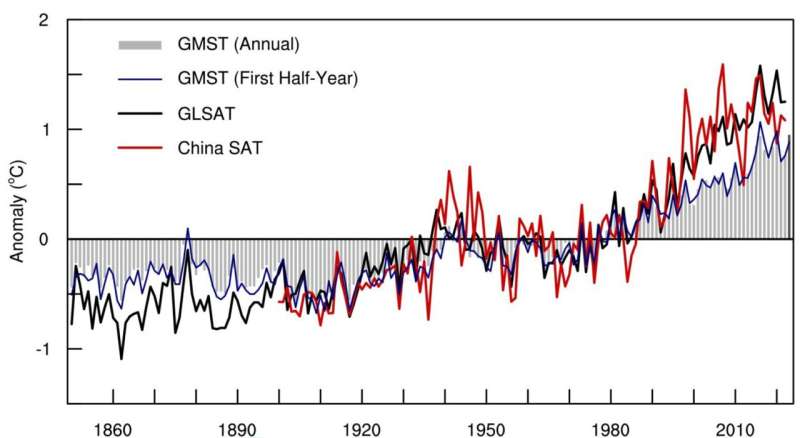This article has been reviewed according to Science X's editorial process and policies. Editors have highlighted the following attributes while ensuring the content's credibility:
fact-checked
peer-reviewed publication
trusted source
proofread
China global Merged Surface Temperature dataset reveals 2023 on track to be hottest year ever

The climate crisis is reaching unprecedented levels of urgency as global temperatures soar to record-breaking heights, with July 2023 marking another alarming milestone. United Nations Secretary-General António Guterres declared it a "disaster for the whole planet," emphasizing that the era of "global warming" has given way to an era of "global boiling."
This alarming assessment is supported by recent findings from Professor Qingxiang Li 's team at the School of Atmospheric Sciences, Sun Yat-sen University, based on the China global Merged Surface Temperature dataset 2.0 (CMST 2.0). Prof. Li is also a distinguished research fellow at the Xinjiang Institute of Ecology and Geography Chinese Academy of Sciences.
Unprecedented monthly highs since May
Professor Qingxiang Li 's team analyzed the CMST 2.0 dataset and discovered that 2023 has already experienced the third hottest first half-year since records began, narrowly trailing behind the warmest year in 2016 and the second warmest in 2020.
The global mean sea surface temperatures (SSTs) surged to an all-time high in April, while global mean land surface air temperatures followed suit by reaching their second-highest monthly level in June. This combination resulted in May being crowned the hottest month ever recorded for global mean surface temperatures.
The research further reveals that global surface temperatures continue to rise into the second half of 2023, driven by factors including El Niño and widespread wildfires. Both global mean SSTs and global mean land surface air temperatures reached unprecedented highs for July, shattering previous records.

Given the current trajectory and short-term forecast results of El Niño, along with the extremely positive phase of the Atlantic Multidecadal Oscillation (AMO), which strongly influences global surface temperatures, 2023 is on track to become the hottest year on record. Moreover, 2024 may witness even higher global surface temperatures.
The research is published in Advances in Atmospheric Sciences.
The CMST 2.0 dataset: A global benchmark
The CMST 2.0 dataset, developed by Professor Li Qingxiang's team, stands as the most comprehensive global surface temperature benchmark dataset to date. It incorporates data from China, filling a critical gap in global temperature monitoring.
The dataset integrates over a century's worth of global land surface air temperature data and incorporates state-of-the-art research from across the globe, resulting in an invaluable resource for climate scientists and policymakers. In 2022, the dataset was expanded to include Arctic surface temperature data, enhancing its global coverage.
Accessible to both the scientific community and the general public, the CMST 2.0 dataset is freely available on the Global Climate Change Observation and Modeling Data Platform at http://www.gwpu.net/en/.
Understanding the complex factors behind global warming
While human activities, including greenhouse gas emissions, are the primary drivers of long-term global warming, short-term variations are influenced by internal climate system changes such as El Niño and the Pacific Decadal Oscillation (PDO). As global warming accelerates, the likelihood of extreme weather events and disasters increases, necessitating urgent action.
Global warming also has profound regional impacts, manifesting in extreme temperature fluctuations. For instance, in East Asia, circulation anomalies like the North Atlantic Oscillation (NAO) have led to frequent extreme cold events in winter, offsetting the overall rise in average temperatures. However, the rise in summer maximum temperatures and the decline in winter minimum temperatures result in larger fluctuations in extreme temperatures.
Furthermore, the pace of human discomfort due to rapid temperature increases, particularly in low-latitude regions, is a growing concern that demands our attention. The CMST 2.0 dataset and Professor Qingxiang Li's team's research underscore the urgency of addressing the climate crisis.
More information: Zichen Li et al, Record-breaking High-temperature Outlook for 2023: An Assessment Based on the China Global Merged Temperature (CMST) Dataset, Advances in Atmospheric Sciences (2023). DOI: 10.1007/s00376-023-3200-9
Journal information: Advances in Atmospheric Sciences
Provided by Chinese Academy of Sciences




















